Wireless Connectivity Market Size
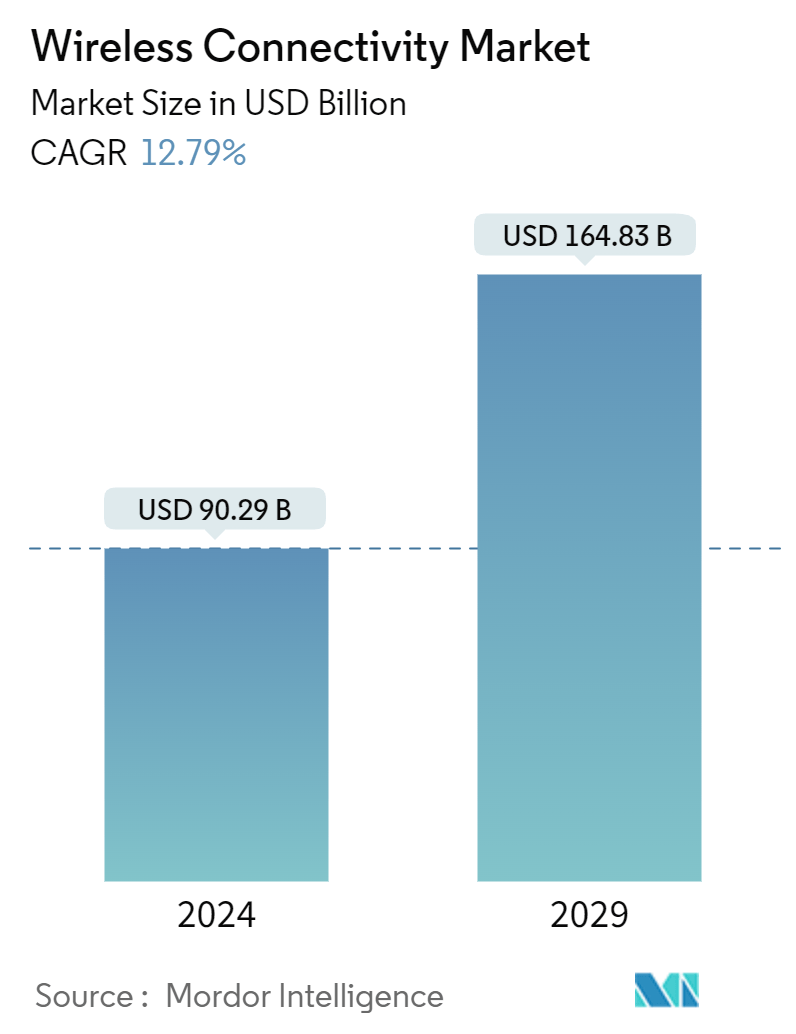
| Study Period | 2019 - 2029 |
| Market Size (2024) | USD 90.29 Billion |
| Market Size (2029) | USD 164.83 Billion |
| CAGR (2024 - 2029) | 12.79 % |
| Fastest Growing Market | Asia-Pacific |
| Largest Market | North America |
Major Players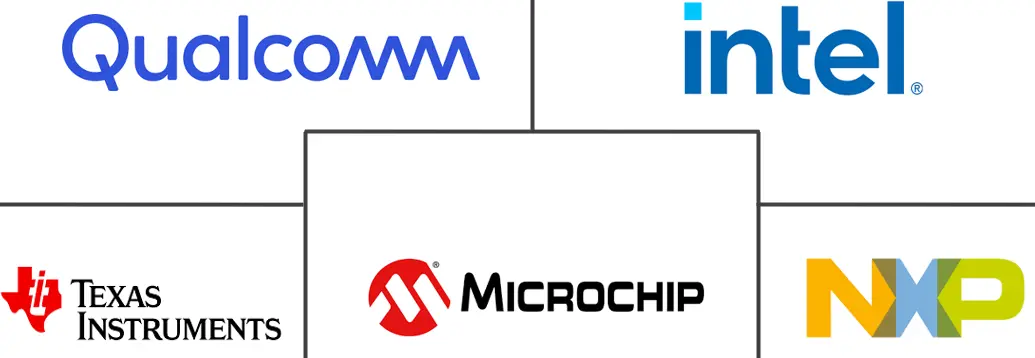
*Disclaimer: Major Players sorted in no particular order |
Wireless Connectivity Market Analysis
The Wireless Connectivity Market size is estimated at USD 90.29 billion in 2024, and is expected to reach USD 164.83 billion by 2029, growing at a CAGR of 12.79% during the forecast period (2024-2029).
- The wireless connectivity market is experiencing significant growth, driven by the increasing demand for seamless internet access and interconnected devices encompassing various technologies, including Wi-Fi, Bluetooth, and Zigbee, enabling data transmission without requiring cables.
- The proliferation of connected devices across various sectors like healthcare and smart homes drives demand for low-power, short-range connectivity solutions, such as Bluetooth and Zigbee. For instance, Amazon’s growing portfolio of Echo smart speakers leverages Wi-Fi and Bluetooth technology for connectivity. In addition, the growing consumer interest in smart home devices, such as smart thermostats, lighting, and security systems, is boosting the demand for wireless connectivity.
- The increasing demand for consumer electronic devices drives the market's growth. Adopting advanced technologies like AI, IoT, AR, and VR is also accelerating demand for wireless connectivity across various industry verticals. The global development of smart infrastructure is also a significant factor in the increasing demand for wireless connectivity.
- Moreover, the increasing investment by governments globally in smart city projects that use wireless connectivity for various applications is propelling the market's growth. For instance, in October 2023, the Department of Information Technology, Electronics & Communication (DITE&C) announced a plan to set up and operationalize more than 100 Wi-Fi hotspots across the state to provide free and seamless internet services. The hotspots will be at selected government offices, bus stands, public parks, citizen service centers, and other locations with high footfalls.
- However, security concerns are restraining the wireless connectivity market's growth as wireless networks are vulnerable to cyberattacks. As wireless communication continues to grow across industries and applications, strong security measures are essential to prevent data breaches and malware attacks. Poor encryption protocols, weak authentication mechanisms, and vulnerable network configurations can reveal sensitive information and compromise the security of wireless systems.
- For instance, according to a survey by the Wireless Broadband Alliance (WBA) as part of the WBA Annual Industry Report 2023, more than a third (33%) of service providers, technology vendors, and enterprises already plan to deploy Wi-Fi 7 by the end of 2023. Further, 44% are planning to adopt Wi-Fi 6E in the next 12-18 months. Such growth prospects in adopting Wi-Fi are anticipated to add significant growth to the wireless connectivity market.
Wireless Connectivity Market Trends
The Automotive Industry is Expected to Drive the Market's Growth
- Bluetooth wireless connectivity is increasingly used in various automotive system equipment to enable wireless communication and connectivity, including hands-free calling, audio streaming, and in-car infotainment systems. By using wireless connectivity like wi-fi and bluetooth, users are able to connect their smartphones and other smart devices to their infotainment systems. Thus, the growth in the sales of automotive vehicles would drive demand for wireless connectivity solutions.
- Modern automobiles increasingly resemble mobile internet of things (IoT) devices and increasingly use a wide range of sensors to enhance driver safety and comfort by collecting and responding to internal and external information. As wireless communications play an essential role in advancing automotive technology, the increasing amount of data produced by applications like advanced driver assistance systems (ADAS) and in-vehicle infotainment is driving innovations in wireless technologies like bluetooth and wi-fi, as well as cellular and adding growth to the market.
- Autonomous vehicles and connected cars are becoming more popular among consumers and are expected to continue to grow over the coming years. The advanced driving assistance systems (ADAS) on display aim to bridge the gap between the cars of today and the cars of tomorrow. In addition, with more technological innovation in the auto industry, end consumers are willing to spend more money on the newest technology that enhances the driving experience and enhances the safety of drivers and passengers. This would drive demand for wireless connectivity solutions for autonomous vehicles.
- Moreover, GM Middle East launched new in-vehicle technology with Google built-in, strengthening connectivity leadership and enhancing the customer experience. General Motors Middle East announced the introduction of infotainment systems with Google built in as part of its vehicle intelligence technology goals. These new features would augment the overall customer experience and make it easier for customers to bring their digital lives into future connected vehicles.
- The Google built-in services would be standard on LT and higher trims, with widespread deployment across all GM vehicle brands equipped with the OnStar module system. Thus, customers in Kuwait and the UAE can utilize Google built-in via their wi-fi plans, while those in KSA and Bahrain can connect through their personal mobile wi-fi hotspots.
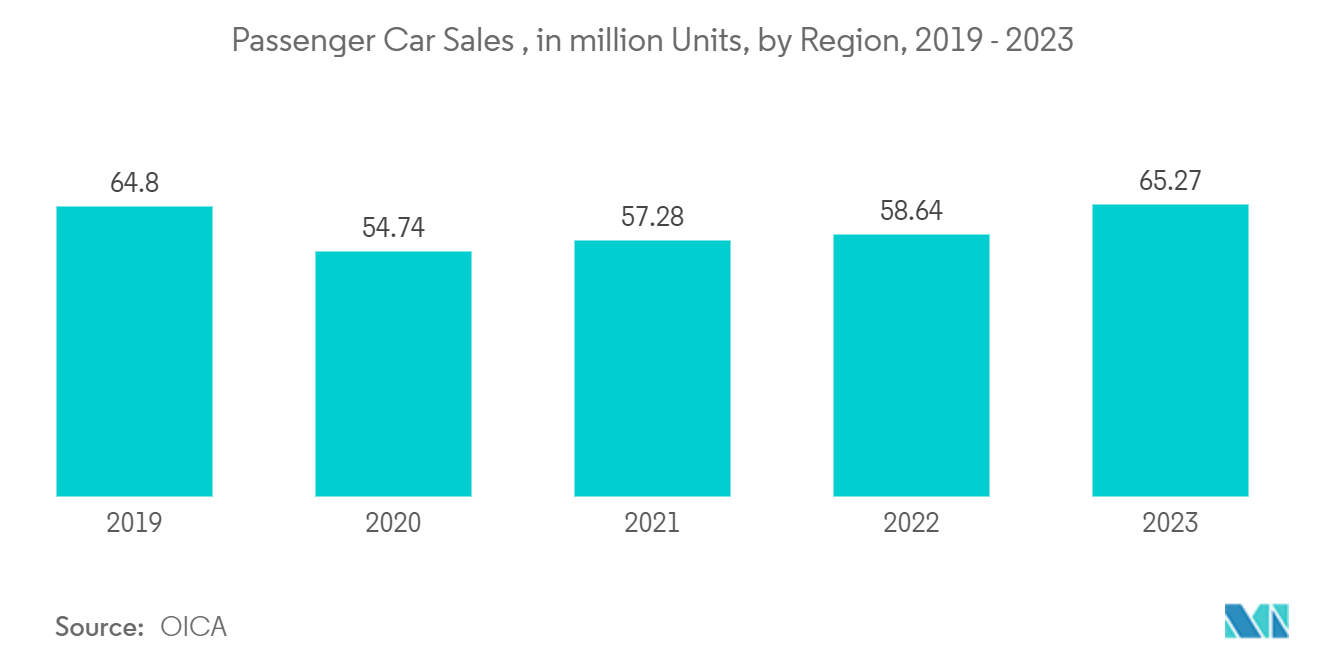
Asia-Pacific is Expected to Register High Growth Rate
- The market expansion in the region is primarily driven by consumers' increased spending and the growing adoption of smart homes. According to a digital survey conducted by Utimaco, a software company, in April 2023, the use of smart home devices has significantly increased in Singapore, with 61% of respondents stating that they are using smart TVs, 43% using home appliances, and 33% using energy saving devices, virtual assistants, and vacuum cleaner robots. This becomes a primary growth factor for the region's increasing adoption of wireless connectivity solutions.
- The rise in the trend towards smart cities is pushing firms or institutions to develop new products or solutions to ease the development of smart cities in the region. For instance, in October 2023, the Living Lab IIIT Hyderabad Smart City, in collaboration with Silicon Labs, a leader in secure, intelligent wireless technology, announced the introduction of a campus-wide Wi-SUN network to support research and solutions for the internet of things (IoT) and smart cities. Such developments are accelerating the demand for wireless connectivity across the region.
- Additionally, the expansion of 5G networks in the region is expected to be one of the major factors driving the growth of market, both directly and indirectly. According to the GSMA's latest report, 5G is expected to contribute about USD 960 billion to the developed economies of East Asia and the Pacific by 2030. 5G is expected to be a significant driving force in automated smart factory deployments in the region.
- The widespread use of the internet of things (IoT) platform in China is increasing rapidly. Given China's leading role in the production of semiconductors and manufacturing, its participation in the advancement and application of the industrial internet of things (lIoT) and the development are expected to create demand for wireless connectivity across end-user industries.
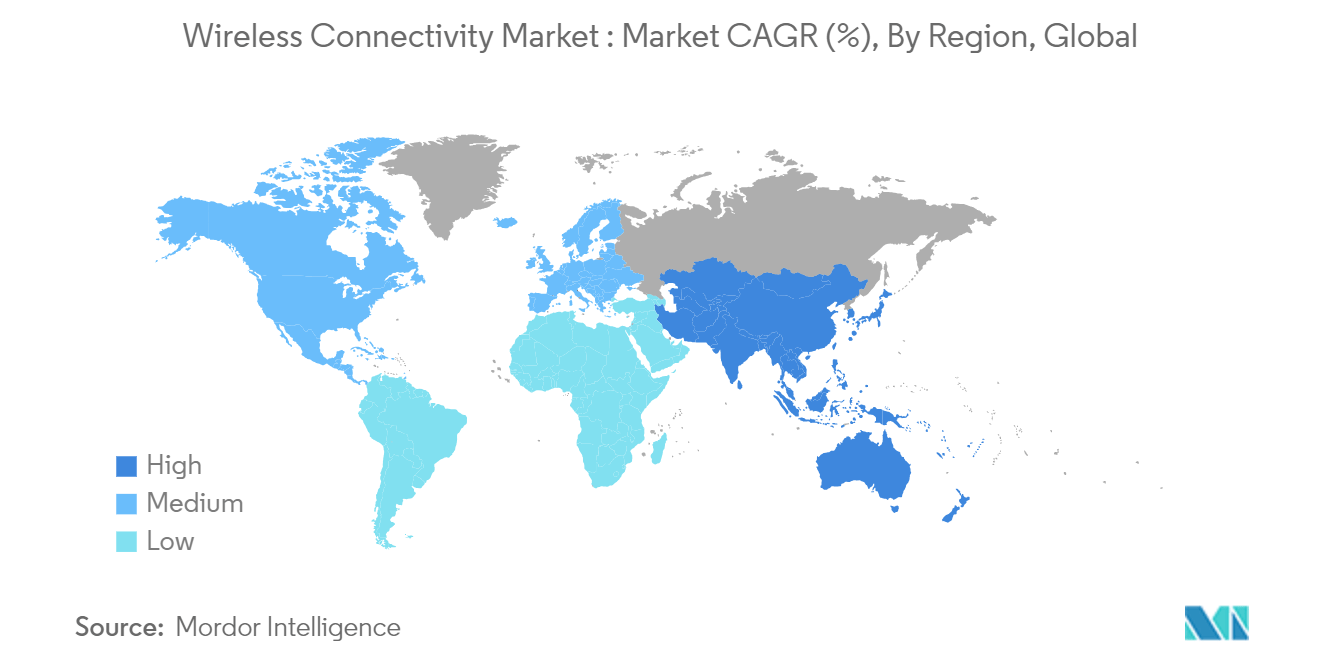
Wireless Connectivity Industry Overview
The competitive landscape for the wireless connectivity market is fragmented, with a large number of players competing in the market, including Qualcomm Incorporated, Intel Corporation, Texas Instruments Inc., NXP Semiconductors NV, and Microchip Technology Inc. The market is witnessing strategic developments, such as product launches, mergers, and acquisitions, to gain a competitive edge.
- In February 2024, Quectel Wireless Solutions, a global IoT solutions provider, launched two new wi-fi modules, the FCU741R and the FCS950R, and bluetooth modules, the HCM010S and the HCM111Z. Through this launch of bluetooth and wi-fi modules, the company aims to empower designers and developers with multiple options, catering to diverse needs in terms of size, cost, and power efficiency.
- In January 2024, Ceva Inc., the licensor of silicon and software IP that enables Smart Edge devices to connect, sense, and infer data reliably and efficiently, and Sunplus Technology Co. Ltd, a chip provider for multimedia and automotive applications have expanded their collaboration to integrate Ceva's latest generation RivieraWaves Bluetooth audio solution into the Sunplus airlyra family of HD audio processors targeting wireless speakers, soundbars and other premium wireless audio devices.
Wireless Connectivity Market Leaders
-
Qualcomm Incorporated
-
Intel Corporation
-
Texas Instruments Inc.
-
NXP Semiconductors N.V.
-
Microchip Technology Inc.
*Disclaimer: Major Players sorted in no particular order
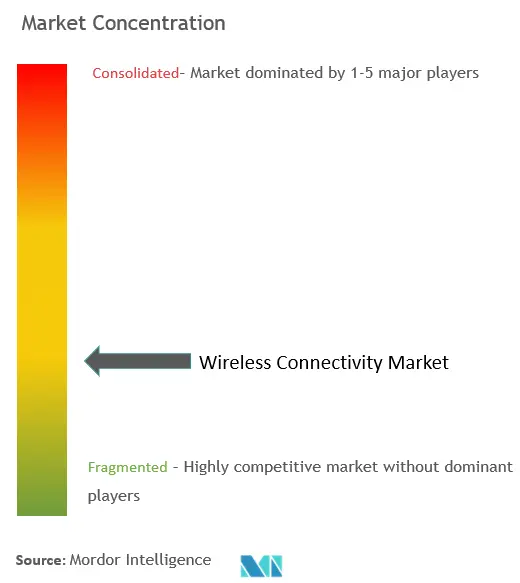
Wireless Connectivity Market News
- April 2024: Qualcomm launched a suite of products with a new ultra-low-power Wi-Fi SoC dubbed QCC730. The company said this new Wi-Fi SoC represents a new category of silicon platforms that would compete with bluetooth for battery-operated IoT devices and across a range of market segments. The new chip operates at 88% lower power consumption compared to previous generation chips.
- February 2024: Wipro Ltd and Nokia Corporation collaboratively introduced a private 5G wireless solution aimed at helping enterprises scale their digital transformation endeavors. Initially, this offering will cater exclusively to customers within the manufacturing, energy, utilities, transportation, and sports entertainment sectors.
Wireless Connectivity Market Report - Table of Contents
1. INTRODUCTION
- 1.1 Study Assumptions and Market Definition
- 1.2 Scope of the Study
2. RESEARCH METHODOLOGY
3. EXECUTIVE SUMMARY
4. MARKET INSIGHTS
- 4.1 Market Overview
- 4.2 Industry Value Chain Analysis
-
4.3 Industry Attractiveness - Porter's Five Forces Analysis
- 4.3.1 Bargaining Power of Suppliers
- 4.3.2 Bargaining Power of Consumers
- 4.3.3 Threat of New Entrants
- 4.3.4 Threat of Substitutes
- 4.3.5 Intensity of Competitive Rivalry
5. MARKET DYNAMICS
-
5.1 Market Drivers
- 5.1.1 Proliferation of IoT and Connected Devices for Robust Wireless Connectivity Solutions
- 5.1.2 Increased Demand for Wireless Sensor Networks to Create Smart Infrastructure
-
5.2 Market Challenges
- 5.2.1 Data Privacy and Security Concerns
- 5.2.2 Lack of Infrastructure, Huge Implementation Cost, and Absence of Technology Know-how
6. MARKET SEGMENTATION
-
6.1 By Technology
- 6.1.1 Wi-Fi
- 6.1.2 Bluetooth
- 6.1.3 Zigbee
- 6.1.4 Other Technologies
-
6.2 By End-user Industry
- 6.2.1 Automotive
- 6.2.2 Industrial
- 6.2.3 Healthcare
- 6.2.4 Energy
- 6.2.5 Infrastructure
- 6.2.6 Other End-user Industries
-
6.3 By Geography***
- 6.3.1 North America
- 6.3.2 Europe
- 6.3.3 Asia
- 6.3.4 Latin America
- 6.3.5 Middle East and Africa
7. COMPETITIVE LANDSCAPE
-
7.1 Company Profiles*
- 7.1.1 Qualcomm Incorporated
- 7.1.2 Intel Corporation
- 7.1.3 Texas Instruments Inc.
- 7.1.4 NXP Semiconductors NV
- 7.1.5 Microchip Technology Inc.
- 7.1.6 MediaTek Inc.
- 7.1.7 Rensas Electronics Corporation
- 7.1.8 Broadcom Inc.
- 7.1.9 STMicroelectronics
- 7.1.10 Nordic Semiconductor
8. INVESTMENT ANALYSIS
9. FUTURE OF THE MARKET
** Subject To AvailablityWireless Connectivity Industry Segmentation
The wireless network comprises a computer network that utilizes wireless data connections between network nodes. Various end-user segments use wireless connectivity to address critical connectivity issues and augment daily operational requirements.
The wireless connectivity market is segmented by technology (wi-fi, bluetooth, zigbee, and other technologies), end-user industry (automotive, industrial, healthcare, energy, infrastructure, and other end-user industries), and geography (North America, Europe, Asia-Pacific, and rest of the world). The market sizes and forecasts are provided in terms of value (USD) for all the above segments.
| By Technology | Wi-Fi |
| Bluetooth | |
| Zigbee | |
| Other Technologies | |
| By End-user Industry | Automotive |
| Industrial | |
| Healthcare | |
| Energy | |
| Infrastructure | |
| Other End-user Industries | |
| By Geography*** | North America |
| Europe | |
| Asia | |
| Latin America | |
| Middle East and Africa |
Wireless Connectivity Market Research FAQs
How big is the Wireless Connectivity Market?
The Wireless Connectivity Market size is expected to reach USD 90.29 billion in 2024 and grow at a CAGR of 12.79% to reach USD 164.83 billion by 2029.
What is the current Wireless Connectivity Market size?
In 2024, the Wireless Connectivity Market size is expected to reach USD 90.29 billion.
Who are the key players in Wireless Connectivity Market?
Qualcomm Incorporated, Intel Corporation, Texas Instruments Inc., NXP Semiconductors N.V. and Microchip Technology Inc. are the major companies operating in the Wireless Connectivity Market.
Which is the fastest growing region in Wireless Connectivity Market?
Asia-Pacific is estimated to grow at the highest CAGR over the forecast period (2024-2029).
Which region has the biggest share in Wireless Connectivity Market?
In 2024, the North America accounts for the largest market share in Wireless Connectivity Market.
What years does this Wireless Connectivity Market cover, and what was the market size in 2023?
In 2023, the Wireless Connectivity Market size was estimated at USD 78.74 billion. The report covers the Wireless Connectivity Market historical market size for years: 2019, 2020, 2021, 2022 and 2023. The report also forecasts the Wireless Connectivity Market size for years: 2024, 2025, 2026, 2027, 2028 and 2029.
Wireless Connectivity Industry Report
Statistics for the 2023 Wireless Connectivity market share, size and revenue growth rate, created by Mordor Intelligence™ Industry Reports. Wireless Connectivity analysis includes a market forecast outlook to 2029 and historical overview. Get a sample of this industry analysis as a free report PDF download.



